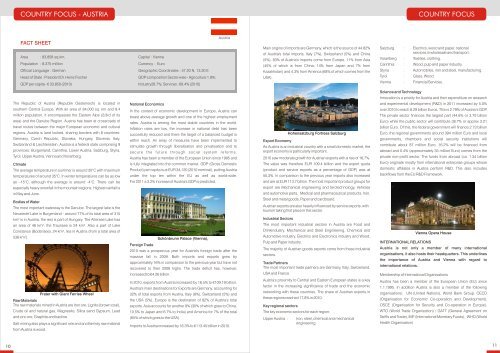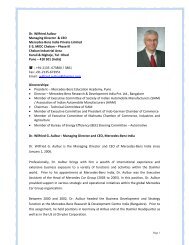Volume 1 - Issue 6 - EU Chambers of Commerce of India
Volume 1 - Issue 6 - EU Chambers of Commerce of India
Volume 1 - Issue 6 - EU Chambers of Commerce of India
Create successful ePaper yourself
Turn your PDF publications into a flip-book with our unique Google optimized e-Paper software.
10<br />
The Republic <strong>of</strong> Austria (Republik Oesterreich) is located in<br />
southern Central Europe. With an area <strong>of</strong> 84,000 sq. km and 8.4<br />
million population, it encompasses the Eastern Alps (2/3rd <strong>of</strong> its<br />
area) and the Danube Region. Austria has been at crossroads <strong>of</strong><br />
travel routes between the major European economic and cultural<br />
regions. Austria is land locked, sharing borders with 8 countries:<br />
Germany, Czech Republic, Slovakia, Hungary, Slovenia, Italy,<br />
Switzerland & Liechtenstein. Austria is a federal state comprising 9<br />
provinces: Burgenland, Carinthia, Lower Austria, Salzburg, Styria,<br />
Tyrol, Upper Austria, Vienna and Vorarlberg.<br />
Climate<br />
COUNTRY FOCUS - AUSTRIA COUNTRY FOCUS<br />
FACT SHEET<br />
Area : 83,858 sq.km. Capital : Vienna<br />
Population : 8.375 million Currency : Euro<br />
Official Language : German Geographic Coordinates : 47.20 N, 13.20 E<br />
Head <strong>of</strong> State : President Dr. Heinz Fischer GDP-composition Sector-wise - Agriculture 1.9%;<br />
GDP per capita - € 33,850 (2010) Industry28.7%; Services : 69.4% (2010)<br />
The average temperature in summer is around 20°C with maximum<br />
temperatures <strong>of</strong> around 35°C. In winter temperatures can be as low<br />
as –15°C, although the average is around -4°C. There can be<br />
especially heavy snowfall in the mountain regions. Highest rainfall is<br />
in May and June.<br />
Bodies <strong>of</strong> Water<br />
The most important waterway is the Danube. The largest lake is the<br />
Neusiedel Lake in Burgenland - around 77% <strong>of</strong> its total area <strong>of</strong> 315<br />
km² is in Austria, the rest is part <strong>of</strong> Hungary. The Attersee Lake has<br />
an area <strong>of</strong> 46 km², the Traunsee is 24 km². Also a part <strong>of</strong> Lake<br />
Constance (Bodensee), 24 km², lies in Austria (from a total area <strong>of</strong><br />
536 km²).<br />
Raw Materials<br />
The raw materials mined in Austria are Iron ore, Lignite (brown coal),<br />
Crude oil and natural gas, Magnesite, Silica sand Gypsum, Lead<br />
and zinc ore, Graphite and kaoline.<br />
Salt mining also plays a significant role and another key raw material<br />
from Austria is wood.<br />
Prater with Giant Ferries Wheel<br />
National Economics<br />
In the context <strong>of</strong> economic development in Europe, Austria can<br />
boast above average growth and one <strong>of</strong> the highest employment<br />
rates. Austria is among the most stable countries in the world.<br />
Inflation rates are low, the increase in national debt has been<br />
succesfully reduced and there the target <strong>of</strong> a balanced budget is<br />
within reach. An array <strong>of</strong> measures have been implemented to<br />
stimulate growth through liberalisation and privatisation and to<br />
secure the future through social system reforms.<br />
Austria has been a member <strong>of</strong> the European Union since 1995 and<br />
is fully integrated into the common market. GDP (Gross Domestic<br />
Product) per capita is at <strong>EU</strong>R 34,120 (2010 nominal), putting Austria<br />
under the top ten within the <strong>EU</strong> as well as world-wide.<br />
For 2011 a 3.2% increase <strong>of</strong> Austria's GDP is predicted.<br />
Foreign Trade<br />
2010 was a prosperous year for Austria's foreign trade after the<br />
massive fall in 2009. Both imports and exports grew by<br />
approximately 16% in comparison to the previous year but have not<br />
recovered to their 2008 highs. The trade deficit has, however,<br />
increased to €4.26 billion.<br />
In 2010, exports from Austria increased by 16.5% to €109.19 billion.<br />
Austria's main destinations for Exports are Germany, accounting for<br />
32% <strong>of</strong> total exports from Austria, Italy (8%), Switzerland (5%) and<br />
the USA (5%). Europe is the destination <strong>of</strong> 82% <strong>of</strong> Austria's total<br />
exports. Asia accounts for another 9% (30% <strong>of</strong> which goes to China,<br />
10.5% to Japan and 6.7% to <strong>India</strong>) and America for 7% <strong>of</strong> the total<br />
(65% <strong>of</strong> which goes to the USA).<br />
Schönbrunn Palace (Vienna),<br />
Austria<br />
Imports to Austria increased by 16.3% to €113.45 billion in 2010.<br />
Main origins <strong>of</strong> imports are Germany, which is the source <strong>of</strong> 44.82%<br />
<strong>of</strong> Austria's total imports, Italy (7%), Switzerland (5%) and China<br />
(5%). 83% <strong>of</strong> Austria's imports come from Europe, 11% from Asia<br />
(45% <strong>of</strong> which is from China, 14% from Japan and 7% from<br />
Kazakhstan) and 4.3% from America (68% <strong>of</strong> which comes from the<br />
USA).<br />
Export Economy<br />
As Austria is an industrial country with a small domestic market, the<br />
export economy is particularly important.<br />
2010 saw moderate growth for Austrian exports with a rise <strong>of</strong> 16,7%.<br />
The value was therefore <strong>EU</strong>R 109.4 billion and the export quota<br />
(product and service exports as a percentage <strong>of</strong> GDP) was at<br />
55,3%. In comparison to the previous year imports also increased<br />
and are at <strong>EU</strong>R 113.7 billion. The most important product groups for<br />
export are Mechanical engineering and terotechnology, Vehicles<br />
and automotive parts, Medical and pharmaceutical products, Iron,<br />
Steel and metal goods, Paper and cardboard.<br />
Austrian exports are also heavily influenced by service exports, with<br />
tourism taking first place in this sector.<br />
Industrial Sectors<br />
The most important industrial sectors in Austria are Food and<br />
Drinkindustry, Mechanical and Steel Engineering, Chemical and<br />
Automotive industry, Electrics and Electronics industry and Wood,<br />
Pulp and Paper industry.<br />
The majority <strong>of</strong> Austrian goods exports come from these industrial<br />
sectors.<br />
Trade Partners<br />
The most important trade partners are Germany, Italy, Switzerland,<br />
USA and France.<br />
Austria's proximity to Central and Eastern European states is a key<br />
factor in the increasing significance <strong>of</strong> trade and the economic<br />
networking with these countries. The share <strong>of</strong> Austrian exports in<br />
these regions reached 17,8% in 2010.<br />
Key regional sectors<br />
Hohensalzburg Fortress Salzburg<br />
The key economic sectors for each region:<br />
Upper Austria : Iron, steel, chemical and mechanical<br />
engineering.<br />
Salzburg : Electrics, wood and paper, national<br />
services in wholesale and transport.<br />
Vorarlberg : Textilies, clothing.<br />
Carinthia : Wood, pulp and paper industry.<br />
Styria : Automobiles, iron and steel, manufacturing.<br />
Tyrol : Glass, Wood.<br />
Vienna : Financial Services.<br />
Science and Technology<br />
Innovation is a priority for Austria and their expenditure on research<br />
and experimental development (R&D) in 2011 increased by 5.0%<br />
over 2010 to reach 8.29 billion Euros. This is 2.79% <strong>of</strong> Austria’s GDP.<br />
The private sector finances the largest part (44.6% or 3.70 billion<br />
Euro) while the public sector will contribute 38.7% or approx 3.21<br />
billion Euro. Of this, the federal government will finance 2.73 billion<br />
Euro, the regional governments around 394 million Euro and local<br />
governments, chambers and social security institutions will<br />
contribute about 87 million Euro. 16.2% will be financed from<br />
abroad and 0.4% (approximately 35 million Euro) comes from the<br />
private non-pr<strong>of</strong>it sector. The funds from abroad (ca. 1.34 billion<br />
Euro) originate mostly from international enterprise groups whose<br />
domestic affiliates in Austria perform R&D. This also includes<br />
backflows from the <strong>EU</strong> R&D Framework.<br />
INTERNATIONAL RELATIONS<br />
Austria is not only a member <strong>of</strong> many international<br />
organisations, it also hosts their headquarters. This underlines<br />
the importance <strong>of</strong> Austria and Vienna with regard to<br />
international relations.<br />
Membership <strong>of</strong> International Organisations<br />
Austria has been a member <strong>of</strong> the European Union (<strong>EU</strong>) since<br />
1.1.1995. In addition Austria is also a member <strong>of</strong> the following<br />
organisations: UN (United Nations), World Bank Group, OECD<br />
(Organisation for Economic Co-operation and Development),<br />
OSCE (Organisation for Security and Co-operation in Europe),<br />
WTO (World Trade Organization) / GATT (General Agreement on<br />
Tariffs and Trade), IMF (International Monetary Funds), WHO (World<br />
Health Organisation)<br />
Vienna Opera House<br />
11



